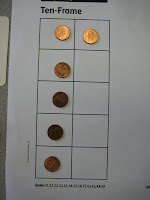The Wolf's Chicken Stew by Keiko Kasza is a favorite in our classroom. Our first experience with it was on the 100th Day of School. We read the story to the students during read-aloud time at the beginning of the day. During a Reader's Workshop mini-lesson, we told the story again by using a flannel board. The boys and girls loved the story so much that it became a highly requested book for the students to read during our Literacy Stations. Because the students related so well to the simplistic storyline of the text, we used it to teach a comprehension mini-lesson on sequence of events and a writing mini-lesson on responding to literature by retelling the story in their writing. During our share chair time in Reader's Workshop, small groups used the flannel board to retell the story in their own words for their classmates. Below is a video of such a retelling. If you have a chance to see our Standards-based Bulletin board outside our room, you will be able to read a few of the retellings the students wrote.
Friday, February 27, 2009
Monday, February 23, 2009
Reading With Intonation
Reading with intonation is our focus in reading this week. During reading conferences we are so pleased to see students apply the strategies they have learned in Reader’s Workshop to their reading. They are using picture clues, looking for sight words, looking for letter combinations, noticing bossy “e” words and two vowels walking. Students are pointing to the words when they need to and they are paying attention to the punctuation. Using these strategies along with the others we have focused on has helped the children to decode the text or read the words. This is a great step to becoming a fluent reader. Now we need to focus on some strategies to help us comprehend or understand what we read. We have noticed that most students are reading the text in a word by word, staccato, monotone manner. The boys and girls will learn to read with intonation and hear how that will help them enjoy the story better. If they like and enjoy the story, then they will better comprehend what they read. You can help your child practice this at home with the book in a bag. Have your child read his or her book twice each night, first to decode the text, and once again to read with intonation. Here is an example of two students reading the same story, The Big Giant. One is reading in a staccato manner and the other is reading with intonation. See if you can hear the difference.


Tuesday, February 17, 2009
Wednesday, February 11, 2009
Pay Attention to Punctuation


The boys and girls have learned another strategy to improve their reading skills. "Paying Attention to Punctuation" has been our focus. When children learn to read, they often read right through the end of a sentence without stopping at periods, question marks, and exclamation points. We have taught the students to read the periods without saying a sound. They should stop at the period and exaggerate closing their mouth so that they pause before reading the next sentence. This is not a natural way to read, but it is a strategy to help beginning readers train themselves to stop and pause at the punctuation that ends a sentence. Much like pointing to the words the readers will eventually pay attention to punctuation without closing their mouth in an exaggerated way.
Tuesday, February 10, 2009
One More, One Fewer

Today we played a new game in Math Workshop. The game was called One More, One Fewer. The students played the game with a partner. There were multiple steps in the game. First the students flipped one card over.

After looking at the number they placed the same number of pennies on a ten's frame.

The students then recorded the number on the game sheet.

Next they rolled a dice. The dice either had a plus one sign or minus one sign. After reading their dice they had to determine whether to add one more penny to the ten's frame or take one away. Finally they recorded their new total on the game sheet. The students loved playing the game. Some of the interesting conversations revolved around what happened when they flipped over a 0. They even thought it was interesting when they flipped a 10 because the ten's frame only has 10 squares. We will play this game again tomorrow now that they know how to play. We can concentrate on the strategies they use to count the pennies, recognize the numbers and add one and take away one.
Monday, February 9, 2009
Tuesday, February 3, 2009
Subscribe to:
Posts (Atom)





